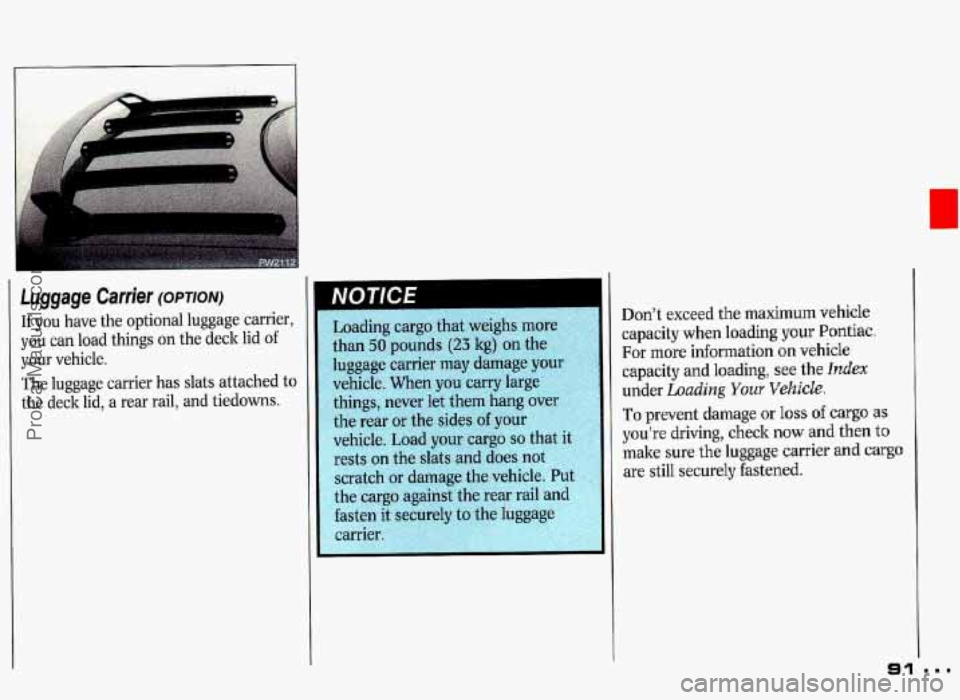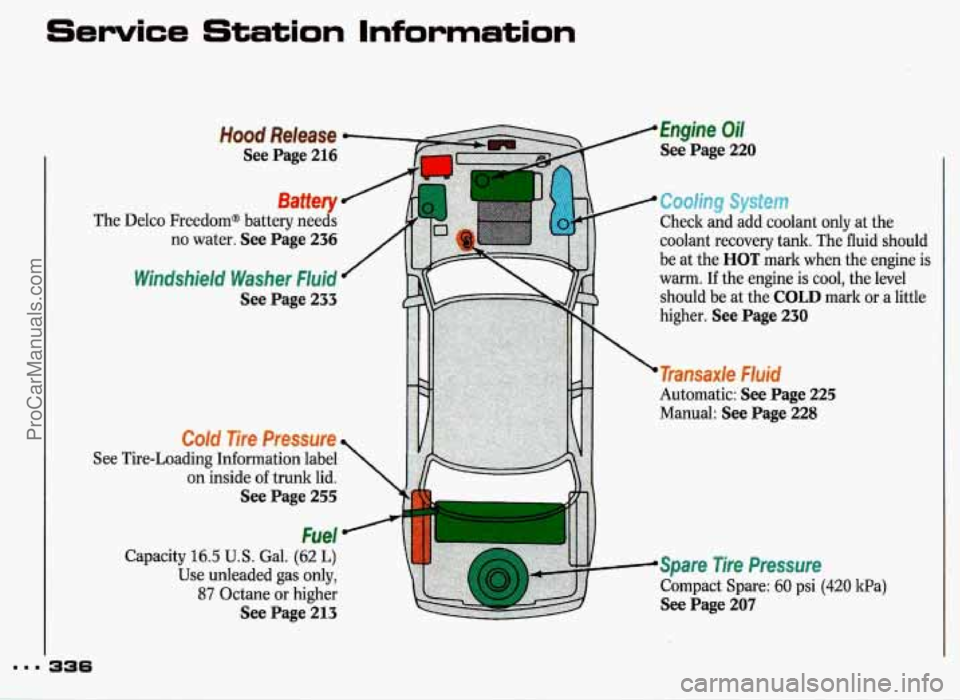1993 PONTIAC GRAND-PRIX load capacity
[x] Cancel search: load capacityPage 92 of 338

Luggage Carrier (OPTION)
If you have the optional luggage carrier,
you can load things on the deck lid
of
your vehicle.
The luggage carrier has slats attached to
the deck lid, a rear rail, and tiedowns. Don’t exceed
the maximum vehicle
capacity when loading your
Pontiac.
For more information on vehicle
capacity
and loading, see the Index
under Loading Your Vehicle.
To prevent damage or loss of cargo as
you’re driving, check now and
then to
make sure the luggage carrier and
cargo
are still securely fastened.
91
n
...
ProCarManuals.com
Page 176 of 338

Do not tow a trailer if your vehicle is
equipped with a 3.4L (VIN Code X)
engine and a manual transaxle.
Your Pontiac can tow a trailer if it is
equipped with a
3.1L (VIN Code T)
engine or a 3.4L (VIN Code X) engine
and an automatic transaxle, and proper
trailer towing equipment.
To identify
what the vehicle trailering capacity is
for your vehicle, you should read the
information in
Weight of the Trailer
that appears later in this section. But
trailering is different than just driving
your vehicle by itself. Trailering means
changes in handling, durability, and fuel
economy. Successful, safe trailering
takes correct equipment, and it has to
be used properly.
That’s the reason for this section. In it
are many time-tested, important
trailering tips and safety rules. Many of these
are important
for your safety and
that of your passengers.
So please read
this section carefully before you pull a
trailer. Load-pulling components such
as the engine, transaxle, wheel
assemblies, and tires are forced to work
harder against the drag of the added
weight. The engine is required to
operate at relatively higher speeds and
under greater loads, generating extra
heat. What’s more, the trailer adds
considerably to wind resistance,
increasing the pulling requirements.
All of that means changes in:
Handling
Durability
Fuel economy
If You Do Decide to Pull a Trailer
If you do, here are some important
points.
There are many different laws having
to do with trailering. Make
sure your
rig will be legal, not
only where you
live but also where you’ll be driving. A
good source for this information can
be state or provincial police.
Consider using a sway control. You
can ask a hitch dealer about sway
control.
Don’t tow a trailer at all during the
first
500 miles (800 km) your new
vehicle is driven. Your engine, axle or
other parts could be damaged.
ProCarManuals.com
Page 178 of 338

Weight of the Trailer Tongue
The tongue load (A) of any trailer is
an important weight to measure
because it affects the total capacity
weight of your vehicle. The capacity
weight includes the curb weight of the
vehicle, any cargo you may carry in it,
and the people who will be riding in
the vehicle. And if
you will tow a
trailer, you must subtract the tongue
load from your vehicle’s capacity
weight because your vehicle will be
carrying that weight, too.
See the
Index under Loading Your Vehicle for
more information about your vehicle’s
maximum load capacity. The
trailer tongue
(A) should weigh
10% of the total loaded trailer weight
(B). After you’ve loaded your trailer,
weigh the trailer and then the tongue,
separately, to see
if the weights are
proper. If they aren’t,
you may be able
to get them right simply by moving
some items around in the trailer.
Total Weight on Your Vehicle’s
Tires
Be sure your vehicle’s tires are inflated
to the limit for cold tires.
You will find
these numbers on the Certification
label at the rear edge
of the driver’s
door,
or see the Index under Tire
Loading.
Then be sure you don’t go
over the GVW limit for your vehicle.
Hitches
It’s important to have the correct hitch
equipment. Crosswinds, large trucks
going by, and rough roads are a few
reasons
why you’ll need the right hitch.
Here are some rules to
follow:
Will you have to make any holes in the
body of your vehicle
when you install
a trailer hitch? If you
do, then be sure
177
ProCarManuals.com
Page 253 of 338

aam
Service & Appearance Care
Windshield Wiper Blade
Replacement
Replacement blades come in different
types and are removed in different
ways. Here’s how to remove the type
with
a release clip:
1. Pull the windshield wiper arm away
2. Lift the release clip with a
from the
windshield.
screwdriver and pull the blade
assembly off the wiper arm.
the wiper arm.
3. Push the new wiper blade securely on
252
Loading Your Vehicle
Two labels on your vehicle show how
much weight it may properly carry. The
Tire-Loading Information label found
on the inside of the trunk lid tells you
the proper size, speed rating and
recommended inflation pressures for
the tires on your vehicle. It also gives
you important information about the
number of people that can be in your
vehicle and the total weight that you
can carry. This weight is called the
Vehicle Capacity Weight and includes
the weight of all occupants, cargo, and
all nonfactory-installed options.
The other label is the Certification label,
found on the rear edge of the driver’s
door. It tells you the gross weight
capacity of your vehicle, called the GVWR
(Gross Vehicle Weight Rating).
The GVWR includes the weight of the
vehicle, all occupants, fuel and cargo.
Never exceed the GVWR for your
vehicle, or the Gross Axle Weight
Rating (GAWR) for either the front or
rear axle.
And,
if you do have a heavy load, you
should spread it out. Don’t carry more
than
167 lbs. (75 kg) in your trunk.
ProCarManuals.com
Page 260 of 338

Warning: The temperature grade for
this tire is established
for a tire that is
properly inflated and not overloaded.
Excessive speed, underinflation, or
excessive loading, either separately or
in combination, can cause heat buildup
and possible tire failure.
Those grades are molded
on the
sidewalls of passenger car tires.
While the tires available as standard or
optional equipment
on General Motors
vehicles may vary with respect to these
grades, all such tires meet General
Motors performance standards and have
been approved for use on General
Motors vehicles.
All passenger type
(P Metric) tires must conform to
Federal safety requirements in addition
to these grades.
Wheel AIignrnenf and
Tire Balance
The wheels on your vehicle were aligned
and balanced carefully at the factory to
give you the longest tire life and best
overall performance.
In most cases, you will not need to have
your wheels aligned again. However, if
you notice unusual tire wear or your
vehicle pulling one way
or the other, the
alignment may need to be reset. If
you
notice your vehicle vibrating when
driving
on a smooth road, your wheels
may need to be rebalanced.
Wheel Replacement
Replace any wheel that is bent, cracked
or badly rusted.
If wheel nuts keep
coming loose, the wheel, wheel bolts,
and wheel nuts should be replaced. If
the wheel leaks air out, replace it
(except some aluminum wheels, which
can sometimes be repaired). See your
Pontiac dealer if any
of these conditions
exist.
Your dealer will how the kind
~f wheel
you need.
Each new wheel should
have the same
load carrying capacity, diameter, width,
offset, and be mounted the same way as
the one it replaces.
If
you need to replace any of your
wheels, wheel bolts, or wheel nuts,
replace them only with
new GM original
equipment parts. This
way, you will be
sure
to have the right wheel, wheel
bolts, and wheel nuts
for your Pontiac
model.
259
ProCarManuals.com
Page 337 of 338

Service Station Information
The
See
Hood Release
See Page 216
Battery
Delco Freedom@ battery needs no water.
See Page 236
Windshield Washer Fluid
See Page 233
Tire-Loading Intomation label
on inside
of trunk lid.
See Page 255
Capacity 16.5 U.S. Gal. (62 L)
Use unleaded gas only,
87 Octane or higher
See Page 213
ProCarManuals.com